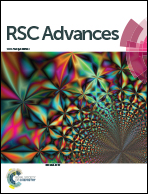Ink-jet patterning of graphene by cap assisted barrier-guided CVD†
Abstract
Barrier-guided CVD growth could provide a new route to printed electronics by combining high quality 2D materials synthesis with scalable and cost-effective deposition methods. Unfortunately, we observe the limited stability of the barrier at growth conditions which results in its removal within minutes due to hydrogen etching. This work describes a route towards enhancing the stability of an ink-jet deposited barrier for high resolution patterning of high quality graphene. By modifying the etching kinetics under confinement, the barrier film could be stabilized and high resolution barriers could be retained even after 6 hours of graphene growth. Thus produced microscopic graphene devices exhibited an increase in conductivity by 6 orders of magnitude and a decrease in defectiveness by 48 times yielding performances that are superior to devices produced by traditional lithographical patterning which indicates the potential of our approach for future electronic applications.



 Please wait while we load your content...
Please wait while we load your content...